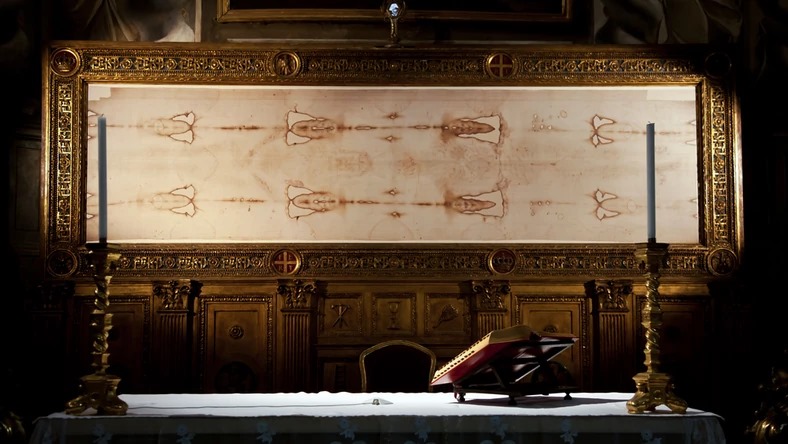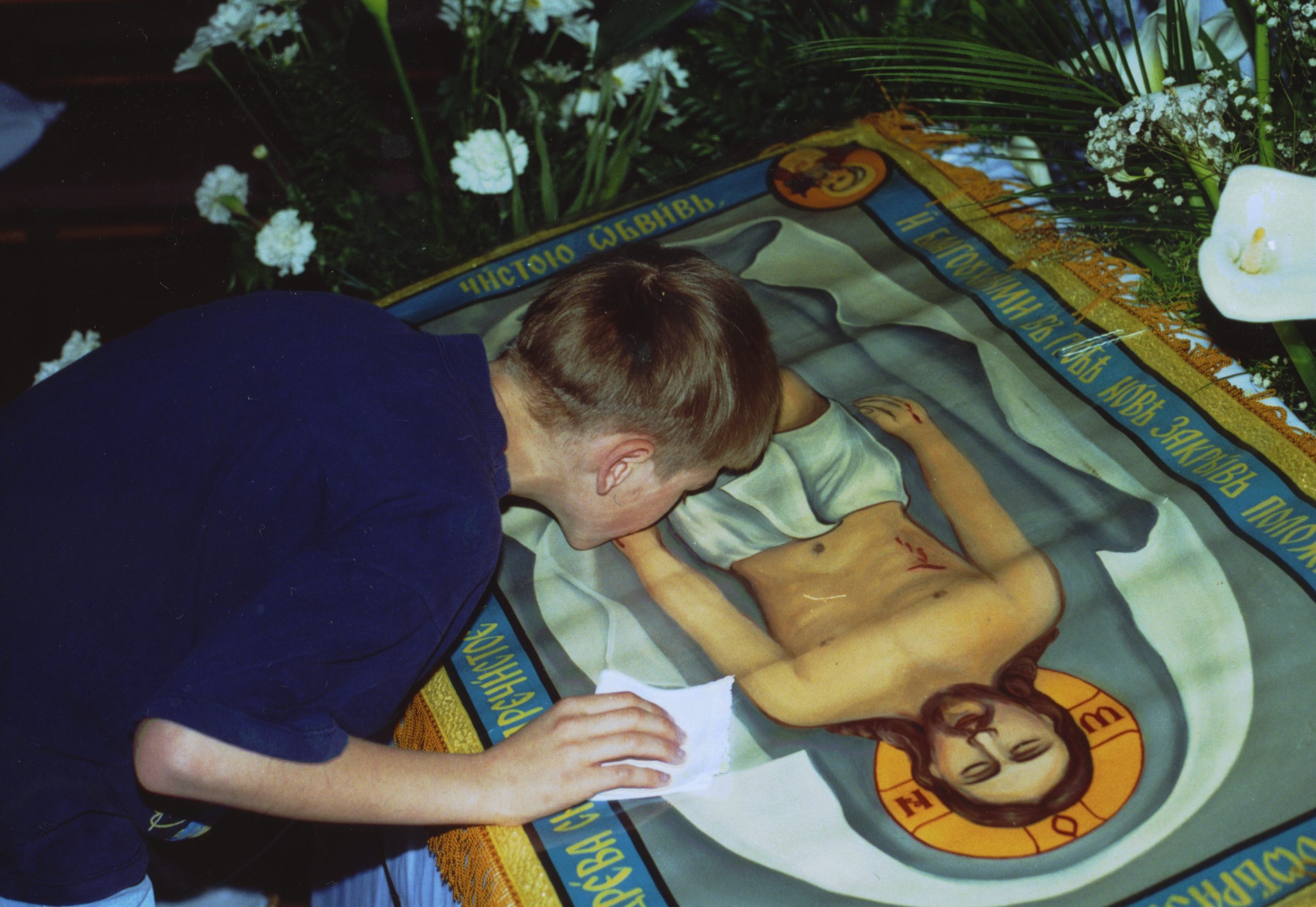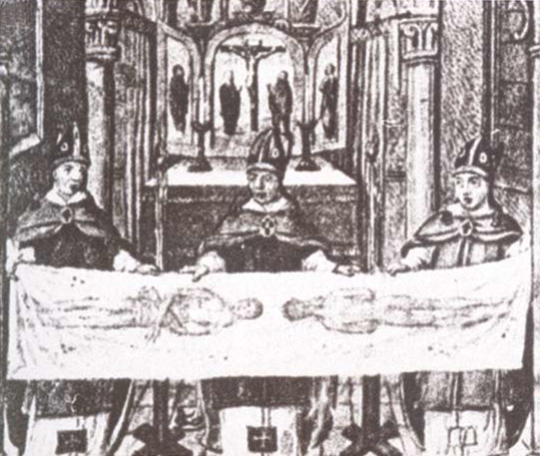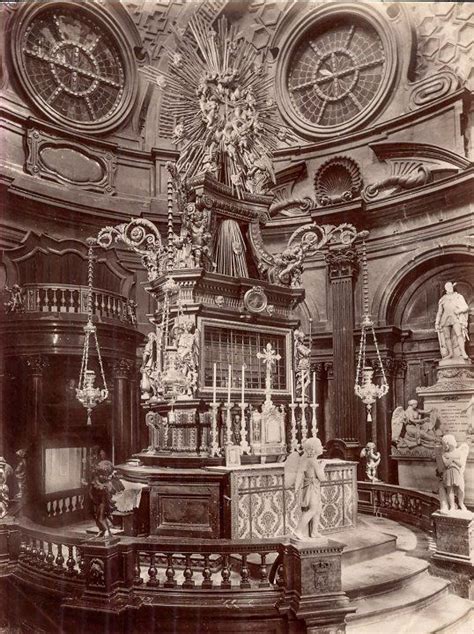The Shroud in the Liturgies
Józef Naumowicz ![]()
Cardinal Stefan Wyszyński University, Warsaw, Poland
The motif of the shroud, the linen in which the body of Jesus was wrapped before being laid in the tomb, appears in the Eucharist, which is called the Divine Liturgy, the Mass, etc., depending on the Christian denomination. This cloth gives symbolic meaning to the altar cloths: those that were laid out on the altar to place the sacrificial gifts on them, as well as those with which these gifts were covered. This interpretation stems from three general themes that have emerged over the centuries, themes that have explained the liturgy differently in the Christian Churches:
1. The Eucharist is the commemoration of (making present) the death and resurrection of Jesus, and therefore the gestures and words of Jesus from the Last Supper and from his passion on Golgotha are repeated during its celebration.
2. The elements of the liturgy refer to the life and death of Christ, especially to his passion and resurrection: the covering of the altar and the vessels with the sacrificial gifts, the carrying of these gifts and the placing of them on the altar were seen as a counterpart to Christ’s passion: his body was taken down from the cross, wrapped in linen and placed in the tomb.
3. The altar is seen as the tomb on which God’s gifts are placed, namely the paten (in Eastern liturgies—the diskos) with bread and the chalice with wine. Both symbolise the laying of Jesus’ body in the tomb (the altar has also been given other meanings and terms: [holy] table—Old Greek: ἡ τράπεζα, Latin: Mensa, because it resembles the table of the Last Supper and the place of the Eucharistic feast or the holy throne or throne of Christ; the place of sacrifice).
These motifs in explaining the liturgy appeared—to varying degrees and in presentation—both in Eastern (especially Greek and Byzantine, which Oriental concepts drew on) liturgical commentaries and in Western, Latin commentaries. It was these that led to the coverings and veils used during the presentation of the gifts on the altar being treated as equivalents of the shroud of Jesus.

Byzantine Liturgy
In early Christianity, the altar was covered with a cloth, which was seen as a symbol of Jesus’ shroud and on which the sacrificial gifts were laid, which were brought in a solemn procession called the Great Entrance. The earliest reference is found in Theodore of Mopsuestia (350–428), who wrote that the procession with the gifts was reminiscent of Christ’s transfer to the tomb, that the laying of the Eucharistic bread on the sacred table symbolises Jesus’ burial, and that Christ is laid on the altar as if in a kind of tomb, as he was laid when he suffered the Passion. Therefore, the deacons who spread the linens on the altar are symbolically showing the grave linens [of our Lord] (Catechetical Homily 15, 26, text preserved in Syriac, Tonneau i Devreesse 1949, p. 505). Because of its symbolism, this linen should be pure (white), as Isidore of Pelusium (†c. 440): The pure shroud (orig. ἡ καθαρὰ σινδών) spread [on the altar] for the administration of God’s gifts on it is an expression of the ministry of Joseph of Arimathea. As he laid the body of the Lord wrapped in the shroud (orig. σινδόνι) in the tomb and there the resurrection took place, so we consecrate the bread laid on the shroud (orig. ἐπὶ σινδόνος), to become the body of Christ (Ep. I, 123, PG 78, 264–265). Here, St Isidore refers to the words of the Gospel that Joseph of Arimathea wrapped the body of Jesus taken down from the cross in clean linen (orig. ἐν σινδόνι καθαρᾷ, Matt 27:59). Linen was considered ritually clean when it was new, did not contain an admixture of other fibres, and had not come into contact with someone’s blood or other ritual dirt. It was also clean from another point of view: there was no image, inscription or other sign on it, which, consequently, were not placed on it at the time. The name of this linen first appears in John IV Postnik, Patriarch of Constantinople from 582–595, and it is iliton (Old Greek: τò εἰλητόν), which etymologically means that which is rolled up, or that with which something is wrapped, entwined or encircled (like the shroud with which Christ’s body was wrapped and which could be folded, rolled up or unfolded). The iliton on which the sacrificial gifts are placed is unfolded on the altar in remembrance of the shroud (orig. εἰς τύπον τῆς σινδόνος), with which Joseph and Nicodemus wrapped the Lord’s body (De sacra liturgia, Pythra, 440–442). Germanus, Patriarch of Constantinople from 715 to 730, wrote almost identically in his systematic commentary on the liturgy: iliton (Old Greek: τò εἰλητόν) means the shroud (Old Greek: τὴν σινδόνα), in which the body of Christ taken down from the cross and placed in the tomb was wrapped. It also explains that the procession of gifts (the Great Entrance) is an imitation of Christ’s burial, when Joseph took the body down from the cross, wrapped it in clean linen, anointed it with spices and myrrh, carried it away with Nicodemus and placed it in a new tomb hewn out of rock. The altar is the image of the holy tomb, and the divine table is the tomb in which the undefiled and most holy body was laid. The patens represent the hands of Joseph and Nicodemus, who buried Christ (On the Divine Liturgy 34 and 37–38, Meyendorff 1984, pp. 82–84 and 86). The iliton was the first form of liturgical shroud or symbol of the shroud of Jesus. It is also laid out on the altar in the current Byzantine liturgy, although it has lost its original symbolic meaning.
The second liturgical covering related to Jesus’ burial cloths were the two small veils placed over the bread vessel (diskos) and the wine cup during the procession to the altar. They were treated as a symbol of the nappies in which Jesus was wrapped while lying in the manger or as a sudarion from Jesus’ tomb. Germanus of Constantinople wrote of the covering of the diskos as being equivalent to the cloth (orig. τοῦ σουδαρίου), which was on Christ’s head and which covered his face in the tomb (On the Divine Liturgy 40, Meyendorff 1984, p. 88). After the diskos was placed on the altar, its covering was removed, folded and put aside; hence, it may have resembled the cloth that the apostles John and Peter saw after Jesus’ resurrection in that it lay not together with the linens but separately rolled up in one place (John 20:7).
Associated with the symbolism of Jesus’ burial was the large, lightweight, sometimes transparent veil with which the two liturgical vessels with the sacrificial gifts were covered when, after the individual small veils had been removed from them, they were incensed. It had a practical function: it protected the gifts from insects, dust or other contamination. Theodore of Mopsuestia wrote about the veils used for this purpose in the liturgy: when, after the Great Entrance, the deacons spread the linens on the sacred table, they stand on either side of the altar and, with their fans, move all the air (Old Greek: ὁ ἀήρ), that is over the sacred body, protecting it so that nothing gets into it (Catechetical Homilies 15, 26). The veil used to cover the gift vessels, which was called air (Old Greek: ἀήρ), was given a symbolic meaning. Initially, it was the equivalent of the stone that secured the entrance to the tomb. According to Isidore of Pelusium, the linen used to cover the chalice and diskos called the air signifies the closure of the tomb (De sacra liturgia, Pythra, 442). Germanus, Patriarch of Constantinople, believed similarly: The covering or air (orig. Τò καταπέτασμα, ἤγουν ὁ ἀήρ) is equivalent to the stone with which Joseph secured the tomb and which Pilate’s guards sealed (Germanus also gives a second meaning of the covering: it is a symbol of the veil in the heavenly temple described in Heb 10—On the Divine Liturgy, 41; Meyendorff 1984, p. 88). Over time, the veil called the air became the main liturgical symbol of the shroud from Jesus’ tomb.
Interpretations of individual altar cloths underwent changes in late Byzantium, when the liturgy there, modelled on the Jerusalem Typikon and the Studite Typikon, reached its final stage of development and acquired a form similar to today’s celebration and the Great Entrance procession was expanded (Taft 1992, pp. 18–19; Ławreszczuk 2009, pp. 181–183). The fullest expression of the new interpretation is given by the treatises of Simeon, Metropolitan of Thessaloniki (1410–1429), still representative of the Orthodox tradition today. The Great Entrance with gifts symbolises the laying of Jesus in the tomb, but also the coming of the Kingdom of God to the world, the solemn entry of Jesus into Jerusalem and the final revelation of Christ in glory. The Holy Table, or altar, signifies Jesus’ tomb and also his throne. Hence, in the rite of consecration of the church and altar, the bishop puts on the pontifical vestments a white robe (literally white shroud—Old Greek: σινδόνα λευκήν) hanging down from his back to his feet, in imitation of Christ’s shroud in the tomb. For it is meant to inaugurate and sanctify the tabernacle of Christ, i.e. the holy table and all that belongs to the tabernacle, and therefore by imitation it becomes an image of Christ buried (De sacro templo 103, PG 155, 309). During the liturgy, the role of the burial cloth is assumed by the tablecloth laid directly on the sacred throne, i.e. on the altar, and called the katasarka (Old Greek: τὸ κατασάρκα—that on which the body of Christ is laid or rests, Old Greek: ἡ σάρξ): it is like a shroud in which the deceased is wrapped (On the Temple of God, 9; Maciejewska 2007, p. 41), signifying the shroud on God’s body that died for us (De sacro templo 113 PG 155, 317; ibid. 133, PG 155, 341).
Simeon, on the other hand, changes the meaning of iliton (Old Greek: τò εἰλητόν), which he does not refer—as earlier commentators on the liturgy did—to the shroud. In his view, this cloth lying on the holy table is an image of the sudarion (Responsa ad Gabrielem Pentapolitanum 22, PG 155, 873), the shawl that the apostles saw together with the burial shroud rolled up in a separate place (John 20:7) (De sacro templo 133, PG 155, 341).
Simeon gives a special meaning to the sacred veil with which the vessels of gifts were covered (usually called aer, air, which in earlier commentators meant the stone enclosing the tomb). It is solemnly brought in during the Great Entrance: some ministers in the procession carry the divine gifts, others over their heads the sacred great veil (orig. τὸ ἱερόν ἔπιπλον), on which is depicted the image (orig. εἰκονισμένον) of the naked and dead Jesus (Expositio de divino templo, Hawkes-Teeples 2011, 126). GAfter the divine gifts have been anointed, the priest puts on the air (orig. τòν ἀέρα), which signifies both the firmament on which the star and the shroud were, and therefore often represents Jesus dead and anointed with myrrh, and is called epitaphios (orig. ἐπιτάφιος). It instructs about the Mystery in a clear and profound way as if it were a painting (orig. ὡς ἐν πίνακι). The fabric reminds us of the fact that Jesus lay in a manger wrapped in nappies and a star stood over him pointing to him to the wise men, and that he was laid in the tomb wrapped in a shroud (De sacra liturgia 110, ibid., 234). The great veil (Old Greek: τò ἔπιπλον), or air (aer), is also called epitaphios because it often contained the image of Jesus in the tomb. Over time, the decoration placed on it becomes more complex: figures of Mary the Mother of God (Incarnation motif), Joseph of Arimathea, Nicodemus and others appear, as well as the community of apostles and, finally, scenes of mourning, as in Byzantine frescoes (Taft 1975, p. 216). This development of the aer is based on the symbolism of the Great Entrance as the funeral procession of Christ and preceded the evolution of the procession of Christ’s burial with the →epitaphios (Old Greek: ὁ ἐπιτάφιος) during the Holy Saturday Lauds (Taft 1975, pp. 217–218).
It was also richly embroidered in the following centuries in both Greek and Slavic Orthodox Churches (aer w Old Church Slavonic: воздух). The scene of Jesus’ burial or mourning dominated on Russian and Ukrainian vozduchs from the 17th–18th centuries (Kosiw 2009, pp. 435–458), then began to disappear as it became the main motif of the antimins/antimension and →epitaphios.

The antimins/antimension (Greek: ἀντιμήνσιον, literally ‘instead of table/altar’), already known in late Byzantium, played an important role in Byzantine liturgies in the Greek and Slavic worlds, including in the Greek Catholic liturgy (Izzo 1975, pp. 33–46). It is a rectangular cloth of linen or silk, with motifs of Christ’s burial, laid out on the altar during the Divine Liturgy, after the Great Entrance.
Today, in Byzantine liturgies, the symbolism of the shroud of Jesus is mainly the antimension, or altar covering, on which the sacrificial gifts are placed along with the great veil, or air (aer), with which the chalice and diskos are covered together (Nowak 2015, pp. 163–168). The reference to the shroud is also evident in the words of the prayers during the bringing of the gifts. In the Liturgy of St John Chrysostom, most commonly celebrated in the Orthodox Churches, when the priest places the chalice and the diskos on the altar he says: “The dignified Joseph, having taken down from the tree your pure Body, wrapped it in a pure shroud and anointed it with spices, placed it in a new tomb.” Similarly, when he covers the vessels with one large veil (aer, воздух), he can say again: “Dignified Joseph, having taken down from the tree your pure Body, wrapped it in a pure shroud and anointed it with fragrances, placed it in a new tomb” (Liturgies… 2014, pp. 85–86).
The Shroud in the Western Liturgy

A similar symbolism relating to the shroud, which in the Byzantine liturgy is fulfilled by the iliton, katasarka and even the antimension and aer, in the Mass of the Roman Church is that of the corporal, which is laid out on the altar at the beginning of the preparation of the gifts and laid down after communion. Its name (Latin: corporale, from corpus—‘body’; palla corporalis) alludes to the linen with which the body (Latin: corpus) of Christ was wrapped, but also to the fact that the sacrificial gifts, unconsecrated, are placed on it, which during the celebration become the Body and Blood of Christ (the body of Jesus refers to his whole person, like his body lying in the tomb).
Originally, the corporal coincided with the tablecloth laid on the altar. Bread was placed directly on it and the chalice with wine was placed on it. The corporal was large enough to be folded at the ends so that these gifts could also be covered with it at the appropriate time. So, they were wrapped with it, just as the body of Jesus in the tomb was wrapped in linen.
Latin sources emphasise that the corporal should be made of natural fabric, in imitation of the “pure shroud” in which Jesus’ body was wrapped. Such a rule was already to be introduced by Pope Sylvester (314–335), who decreed that the sacrifice was not to be celebrated on silk or dyed linen, but only on a cloth of linen, as the body of our Lord Jesus Christ is buried in a white linen cloth (Liber Pontificalis 34, 7). The prescription is probably somewhat later than the time of this pope, although it dates from before the final redaction of the text in the 6th century. Similarly recommended was the Lectionary of the Gallican Liturgy attributed to Germanus, Bishop of Paris (496–576), which depicted the liturgy in the Gallican Rite celebrated in Gaul before the time of Charlemagne: The corporal (Corporalis palla), on which the sacrificial gifts are placed is of pure linen, because the Lord’s body was wrapped together with the fragrances in pure linen (puris linteaminibus) in the tomb.

The covering of the sacred gifts, on the other hand, may be adorned with silk, gold or precious stones to symbolise the glory of Jesus’ resurrection. Moses also adorned the curtains of the tabernacle in this way (Expositio liturgiae gallicanae in duas epistolas, ep. 1, PL 72, 93). Bede the Venerable (c. 700), while commenting on the Gospel according to St Mark (Mark 15:46) which describes that Joseph of Arimathea bought the cloth (orig. sindonem) and laid Jesus in the tomb wrapped in it (orig. sindone), explained that he wrapped Jesus not in gold, precious stones or silk, but in pure linen (orig. linteamine puro), in a pure shroud (orig. in sindone munda). And so it should be in the liturgy: Hence comes the custom of the Church to celebrate the sacrifice of the altar not on silk or dyed tablecloth, but on linen cloth of linen itself, as Our Lord’s body was buried in a pure shroud (in sindone munda), as decided, as we read in the Pontifical Books, by Blessed Pope Sylvester (In Marci Evangelium expositio, PL 92, 292–294). Hraban Maur (9th century) explained that the cloth on the altar signified the linen with which the body of Jesus was wrapped and it should be of pure linen and not silk or dyed cloth (De institutione clericorum I, 33, PL 107, 323). This opinion was also repeated by medieval authors when, in the 11th and 12th centuries, the size of the corporal was reduced (the amount of Eucharistic bread laid on it was reduced). Henceforth, the corporal is spread on the tablecloth with which the altar is covered. This is a square-shaped white cloth on which the chalices and paten with the hosts are placed during the celebration of the liturgy. There was also a need for a separate covering for the chalice. Pope Innocent III, while still a cardinal, wrote that there are two fabrics associated with the burial cloths of Jesus used in the Mass, which are called corporals: one unfolded on the altar signifies the cloths with which the body of Jesus was wrapped, the other remains folded and is laid over the chalice, signifying the veil (sudarium) that was on his head and then folded separately in one place (De sacro altaris misterio II, 56, PL 217, 832).
That the altar cloths were identified with the shroud of Jesus is attested to by the prayer over the corporal—called Oratio super sindonem—said when they are laid out on the altar at the beginning of the offertory. It originated in the early Middle Ages. It existed in the ancient Roman and Gallican liturgy (Chavasse 1960, pp. 313–323; Chavasse 1957, pp. 190–195) and is still preserved in the Ambrosian liturgy. The current Missal of this liturgy gives the Orationes super sindonem appropriate to the day and explains that at each Mass the priest recites one or more Super sindonem prayers (Ordinarium, 15). The title of this prayer (Super sindonem) and the moment at which it is said express the ancient idea that the linen spread on the altar is the symbolic equivalent of Jesus’ shroud, and that the laying of the gifts on it recalls the laying of Jesus’ body in the tomb.
Primary Sources
St Germanus of Constantinople, On the Divine Liturgy, ed. and transl. P. Meyendorff, Crestwood 1984.
Izydor z Peluzjum, De sacra liturgia, ed. J.-B. Pitra, [in:] Spicilegium Solesmense, Vol. 4, Parisiis 1858, pp. 440–442.
Ordinarium Missæ juxta ritum Sanctæ Ecclesiæ Mediolanensis, Mediolani 2012.
Symeon z Tessaloniki, Expositio de divino templo i De sacra liturgia, ed. and transl. S. Hawkes-Teeples, [in:] St Symeon of Thessalonika, The Liturgical Commentaries, ed. and transl. by S. Hawkes-Teeples, Toronto 2011.
Symeon z Tessaloniki, O Świątyni Bożej, przeł. A. Maciejewska, Kraków 2007.
Teodor z Mopuestii, Homilie katechetyczne, [in:] Les Homélies catéchétiques de Théodore de Mopsueste, trad., introd., index par R. Tonneau en collab. avec R. Devreesse, Vaticano 1949.
Woodbrooke Studies: Christian Documents in Syriac, Arabic, and Garshūni, ed. and transl. with a critical apparatus by A. Mingana with introductions by R. Harris, Vol. 6, Cambridge 1933.
References
Chavasse A., L’oraison “Super sindonem” dans la liturgie romaine, “Revue bénédictine” 1960, Vol. 70, pp. 313–323, https://doi.org/10.1484/J.RB.4.00418.
Chavasse A., Le sacramentaire gélasien (Vaticanus Regmensis 316), sacramentaire presbytéral en usage dans les titres romains au VIle siècle, Tournai 1957, Bibliothèque de théologie. Série IV. Histoire de la théologie, 1.
Izzo J.M., The Antimension in the Liturgical and Canonical Tradition of the Byzantine and Latin Churches: An Inter-Ritual Inter-Confessional Study, Romae 1975.
[Kosiw R.] Косів P., Плащаниці у церковній традиції: символіка, походження та іконографія, [in:] Szczelina światła. Ruskie malarstwo ikonowe, red. A. Gronek, Kraków 2009, pp. 435–458.
Liturgie Kościoła prawosławnego, przeł. H. Paprocki, Kraków 2014, Biblioteka Ojców Kościoła, No. 20.
Ławreszuk M., Historyczny rozwój Typikonu jerozolimskiego i jego współczesna rola, “Elpis” 2009, No. 11, pp. 167–198.
Nowak A.Z., Materiały niekonieczne w księgach liturgicznych: objaśnienia dla kapłanów na przykładzie antimensionu, [in:] O miejsce książki w historii sztuki, pod red. A. Gronek, Kraków 2015, pp. 163–168.
Taft R.F., The Byzantine Rite: A Short History, Collegeville 1992, American Essays in Liturgy Series.
Taft R.F., The Great Entrance: A History of the Transfer of Gifts and Other Preanaphoral Rites of the Liturgy of St. John Chrysostom, Rome 1975.
Woodfin W.T., The Embodied Icon: Liturgical Vestments and Sacramental Power in Byzantium, Oxford 2012, https://doi.org/10.1093/acprof:osobl/9780199592098.001.0001.
Sources of Images
1. Collection and ownership of the Polish Syndonological Centre in Kraków
2. Wikimedia Commons, https://commons.wikimedia.org/wiki/File:Plastenica_Trebisov_baziliansky_monastyr_bozkanie_1999.jpg (Misko3, CC BY-SA 4.0)
3. Kim jest Człowiek z Całunu? [exhibition brochure], Kraków 2012
4. Atlante de Torino, http://www.atlanteditorino.it/Sindone/album/index.html (educational use)
